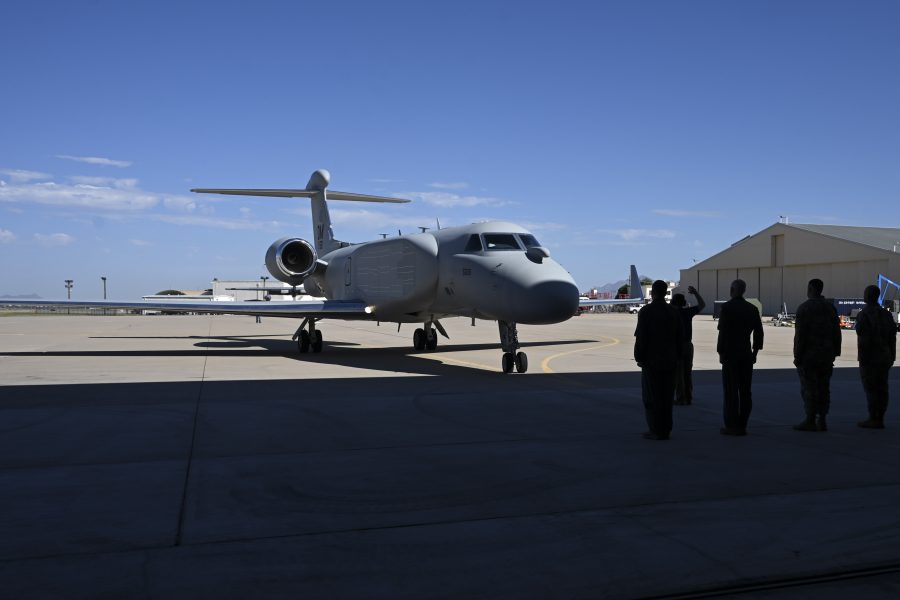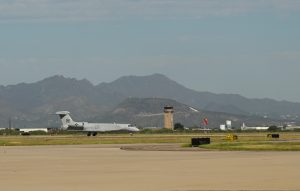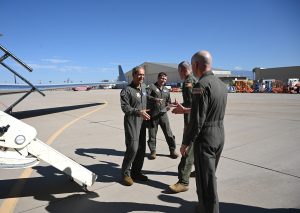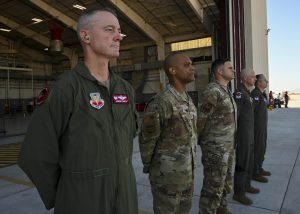The Air Force’s first mission-ready EA-37 Compass Call aircraft flew into Davis-Monthan Air Force Base, Ariz., last week, the start of a major upgrade to the service’s electronic warfare fleet.
Air Combat Command boss Gen. Kenneth S. Wilsbach, 16th Air Force commander Lt. Gen. Thomas Hensley, and 55th Wing commander Col. Mark Howard all flew on the new aircraft to deliver it to its new home Aug. 23 and hailed its arrival as a key moment for the Air Force.
“The EA-37B is the right choice right now because as we continue to pivot toward great power competition, we have adversaries that are developing long-range kill chain ecosystems and anti-access area denial capabilities,” Hensley said in a statement. “The Compass Call will allow us to do things in the non-kinetic spectrum as well as the electromagnetic spectrum to give us the advantage and not them.”
The EA-37 is replacing the EC-130H Compass Call, which is aging and struggling—at the end of fiscal 2023, there were just six remaining aircraft in the fleet, with an average age of 49 years and a mission capable rate of just 33 percent. Since then, another aircraft has been retired, leaving just five.
“The EC-130 has served its purpose for years, but this new airframe and its delivery mean that we have a combat-credible threat,” Howard said.
Based on a Gulfstream G550 business jet modified by L3Harris, the EA-37’s mission hardware is built by BAE. Back in September 2023, the first jet was delivered to the Air Force for testing.
The new jet will be able to conduct jamming of radars, electronic systems and communications. The aircraft will also play a role in the Suppression of Enemy Air Defenses (SEAD) mission by disrupting an enemy’s ability to coordinate sensors and command-and-control weapon batteries that target friendly aircraft.
It will also have better speed and altitude than the EC-130—the EA-37B can fly at 40,000 feet and 600 knots versus the EC-130’s ceiling of 25,000 feet and 300 knots.
At Davis-Monthan, the first aircraft will be used for pilot training to start, with another jet scheduled to arrive before the end of the year and five more in 2025. All told, the service plans to buy 10 of the new aircraft.
It’s all part of series of changes to both the broader Air Force’s EW capabilities and Davis-Monthan’s assets.
Since the retirement of the EF-111 in the late 1990s, the service’s electronic attack capabilities have narrowed. The establishment of the 350th Spectrum Warfare Wing a few years ago has reignited focus on EW, and the new jet will add a fresh airborne element at a time when leaders said EW is only getting more and more important.
Meanwhile, Davis-Monthan is shifting from legacy platforms like the EC-130, HH-60G, and A-10 to new flying missions like the EA-37, the HH-60W, and a “Power Projection Wing” for Air Force Special Operations Command. The service also stood up one of its first Air Task Forces at the base last month.



